Press Release: QAD Redzone is Front Runner in LNS Research Connected Frontline Workforce Applications Solution Selection Matrix Read Now
December 4, 2023

Welcome to Coaching Q&A, a series we’re running in our Factory Miracles magazine and on our website. We’ll share insights into our coaches’ backgrounds, motivations, and experiences working with customers.
Coaching Q&A: Meet Taylor Windatt, Operational Excellence Lead Coach, QAD Redzone
I spent five years in the Marine Corps as an intelligence analyst in Japan, Thailand, and the Philippines, before being sent to Afghanistan. After I was discharged, I went to college. Then, I worked at UPS and Amazon as an Operations Manager.
I joined QAD Redzone as a Readiness Coach – that’s the role the company has for new hires who want to move into coaching but don’t have a manufacturing background. So, prior to a launch week, I’d go onsite with the client for two to three days, work closely with the Project Manager to validate signal data, and do some training with the core operator team. You get a good understanding of different factories and manufacturing processes as you move from one site to the next.
I was a readiness coach for about a year before I became an OpEx Coach, which I have done for two and a half years prior to becoming a Lead Coach. I still work onsite with customers but also spend four weeks a year mentoring new hires. I shadow new coaches on their first deployment to provide feedback and guidance and work on strategic projects for QAD Redzone.
2. Why is manufacturing an exciting, dynamic industry to work in?
One thing I really appreciate is the opportunity to work with operators. They might not have received the attention they needed in the past, or they might feel like they don’t have a voice in how things are done.
We give them one-on-one support and a tool to connect and collaborate with other team members and share ideas. So now they have a direct line to the Plant Director. If they have an idea, they can submit it, and less than 24 hours later, the Plant Director will read it.
It’s exciting to see how workers get empowered and start solving problems. It’s also great to see how our new coaches grow and progress and become experts in using QAD Redzone to solve the production, maintenance, and quality issues our customers struggle with.
3. How did you learn about QAD Redzone, and why did you decide to join as a coach?
I was working at Amazon and wanted to make a change. One day, I saw a QAD Redzone ad for a Continuous Improvement Coach on LinkedIn and thought it sounded great. I interviewed for the job and got an offer to join as a Readiness Coach.
During the interview, I asked a lot of questions and learned that QAD Redzone had a very team-driven culture which was incredibly appealing to me. It was clear that the company had a good culture and that everyone worked together to help their customers move forward. I knew I wanted to be a part of this.
4. What was your most memorable deployment and why?
Taffy Town is a candy company based in Utah. It’s a family-run business. Everyone was super friendly from the leadership level down when I came onsite.
The leadership team really values the operators. They don’t see the operators as button-pushers. They see them as individual people who have great ideas and know how to run and fix the equipment.
Taffy Town was a pretty exciting deployment. The operators who work there delivered a 100% productivity improvement over the course of deploying all four QAD Redzone modules.
Most of the production team is Spanish-speaking. They used QAD Redzone’s language translation capabilities to share ideas on how to improve processes.
Taffy Town’s culture was already outstanding. But now it’s fantastic. One thing that’s unusual about Taffy Town is they know how to celebrate.
At monthly meetings, the owner comes out with this big wheel with different dollar amounts. So, if the plant has hit a new record, everyone gets to come up and spin it. And whatever dollar amount it lands on, he hands it over to that person.
He does the same thing for birthdays and work anniversaries. The owner is playing music, dancing, and giving out cash. And they always cater food. So, it’s this big party. And he doesn’t click through slides. The owner just talks to his team. “We hit this new record. Here’s how we’re doing on our volume.” Operators will take pictures on their phones or iPads and send them to the overhead TV. So, every morning, when you walk in, you look at the TV and see photos of the people working on the lines. They’re smiling. They’re doing goofy things. It’s a unique culture. They’re a real team – that’s why they’re so successful.
5. What are the key things you are looking for when you visit a QAD Redzone customer site for the first time?
When I sit down for the initial meeting, the first thing I’m looking for is leadership engagement. If the entire leadership team is there, asking good questions and saying, “Let us know what we can do to help support this project,” I know it will be a good deployment.
If either the leadership team or operators are disengaged, then I need to do some significant adjusting.
I try to build rapport with the teams I work with. I wear cowboy boots onsite and have my dogs as a screen saver on my iPad. So, before I start presenting, the production team is looking at my dogs. That’s usually a bit of an icebreaker.
With operators, we’re taking the way that they work and completely changing it. So, a lot of times when I meet with teams initially, they have a lot of passion that’s easy to misunderstand as irritation. However, the teams want to do a good job and are trying to understand QAD Redzone and the logic behind it.
It’s important to get involved with teams beyond just training them. I talk to operators while they’re running the line to understand their concerns. They may not think they have enough time to use QAD Redzone, or they may not be comfortable with the technology. And so, once I know what the issues are, I can address them. It’s often beneficial to talk to the operators one-on-one, but a big win never hurts. So, I try to find a pain point for an individual operator or maintenance supervisor and solve it.
At a recent deployment, we had a Maintenance Manager who would sit in meetings with his arms crossed and try and poke holes in QAD Redzone and how it worked. His mindset was very much that operators break things and don’t really know what’s going on.
Because of his role, it was very important that he buy into how processes would be changing. So, I included him in meetings and had him work with operators to address maintenance issues proactively. The manager went from writing all his work orders on a whiteboard to having them preloaded into QAD Redzone.
He began asking to review his activities. And then the manager said, “I wasn’t sure about QAD Redzone. But it has been awesome for us. We’ve gotten a lot of issues fixed because we now have visibility into what’s going wrong. And we’re using the ideas that came from the floor to prioritize repairs, which is keeping us from firefighting as much.” Before QAD Redzone, the maintenance team sometimes had to come in during the middle of the night to fix the equipment.
6. What is the most satisfying part of your job?
There are two things I really appreciate. One is working with brand-new coaches and being able to help them when they’re confused or frustrated. We jump on a quick call, walk through what they’re struggling with, and figure out the best way to approach it.
The other thing that’s great is to walk into a plant and see how the culture changes with QAD Redzone. On day one, the operators may not be in a good mood. They really don’t want to change. And then 90 days later, they’re smiling, engaging with leadership, and doing great things with AD Redzone.
7. What would be your advice to those starting their coaching career in manufacturing?
When I moved into coaching, I felt like I was on an island. The support structure wasn’t there. I don’t want anybody else to have to go through that.
My biggest advice is to use your Lead Coaches, team members, and hiring group and just ask questions. There are no stupid questions.
Everybody has been through the same thing. You’re onsite with a customer, drinking from a firehose, and trying to get 100 things done each day. Then, you’re going back to the hotel at night and focusing on what you will do with the teams the next day.
The great thing about our team is that anyone will pick up a call from another coach, even if it comes in at 9 or 10 p.m. at night. If another coach says, “Hey, I’m struggling. Can you walk me through something?” No one’s going to say no. I think that says a lot about our company.
1,000 Factories’ Productivity Data: The Largest Dataset of Its Kind ...

Contact us and let's begin empowering your frontline and growing your bottomline.
